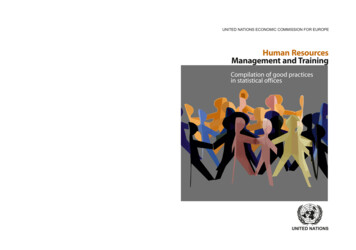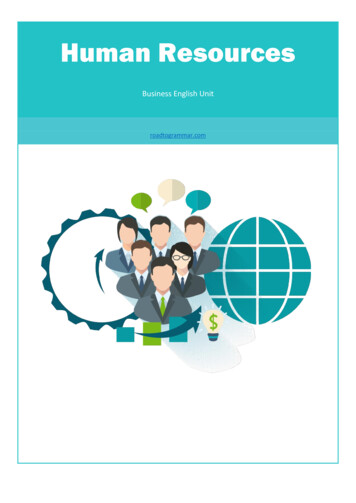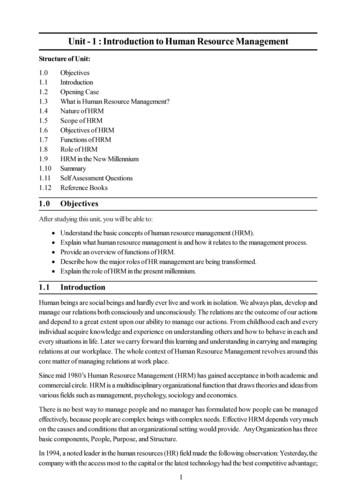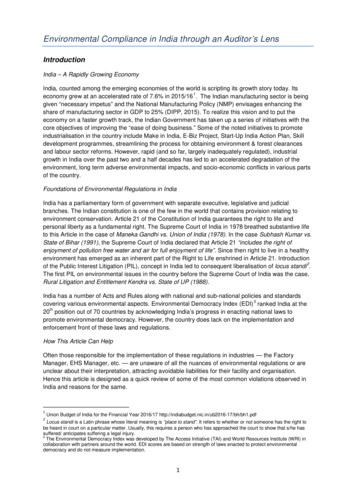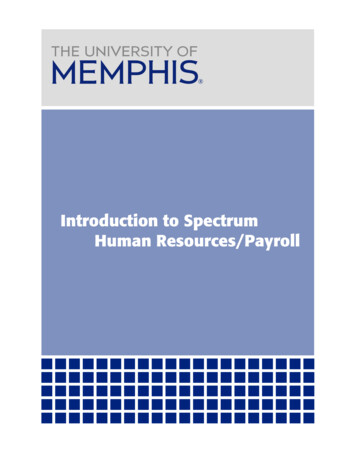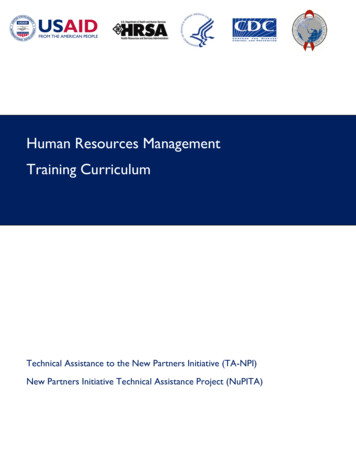
Transcription
Human Resources ManagementTraining CurriculumTechnical Assistance to the New Partners Initiative (TA-NPI)New Partners Initiative Technical Assistance Project (NuPITA)
The New Partners Initiative Technical Assistance (NuPITA) project is funded by the United States Agency forInternational Development (USAID) and implemented by John Snow, Inc. and Initiatives Inc., contract GHS-I-0007-00002-00.This document is made possible by the generous support of the American people through USAID. The contentsare the responsibility of John Snow, Inc. and do not necessarily reflect the views of USAID or the United StatesGovernment. 2010 John Snow, Inc.NuPITAJohn Snow, Inc.44 Farnsworth StreetBoston, MA 02210-1211Phone: 617.482.9485www.jsi.com
Table of ContentsI. Introduction . iOverview . iiII. Session Guide . 1Session 1: Introduction . 1Session 2: Human Resources Management and Organizational Strategy . 4Session 3: Change Management . 7Session 4: Policy and Planning . 9Session 5: Recruiting and Retaining Staff . 12Session 6: Establishing Salary Structures . 15Session 7: Staff Engagement and Team Building . 17Session 8: Timesheet Management . 22Session 9: Performance Management . 25Session 10: Action Plan Presentations . 28III. Appendices . 29Appendix A: Sample Agenda . 29Appendix B: Handouts. 31Handout 1-1: HRM Best Practices Checklist . 31Handout 2-1: OCA Outline . 32Handout 2-2: OCA Discussion Responses . 33Handout 2-3: HR Strategy Scenarios . 35Handout 2-4: Guidance for HRM Strategy Scenarios . 36Handout 2-5: Sample HRM Action Plan . 38Handout 2-6: HRM Action Plan Template . 39Handout 3-1: Guidance for Tracking Staff Movements Exercise . 41Handout 3-2: Change Wheel . 42Handout 4-1: Guidance for Staffing Needs Assessment Case Study . 43Handout 4-2: Staffing Needs Assessment Case Study . 47Handout 4-3: Staffing Needs Case Study Worksheets . 50Handout 4-4: Sample Employee Manual . 52Handout 5-1: Job Design Checklist . 67Handout 5-2: Job Description . 68Handout 5-3: Job Advertisement/Announcement Sample and Worksheet. 71Handout 5-4: Interviewing Suggestions . 72Handout 5-5: Recruiting Strategy Plan Guidelines . 74Handout 5-6: A Summary of Turnover and Retention . 75
Handout 6-1: Guidance for Salary Structure Exercise . 76Handout 6-2: Salary Structure Exercise . 81Handout 6-3: Sample Salary Scales . 84Handout 7-1: Employee Engagement Questionnaire . 86Handout 7-2: Teambuilding Lessons We Can Learn from Geese . 87Handout 7-3: Team Building Scenarios. 88Handout 7-4: Possible Responses for Team Building Scenarios . 89Handout 7-5: Conflict Case Study . 90Handout 8-1: Timesheet Exercise. 91Handout 8-2: Sample Timesheet . 92Handout 8-3: Sample Paid Time Off Tracking Worksheet . 93Handout 8-4: Sample Payroll Tracking Sheet . 94Handout 8-5: Timesheet Management Case Study. 95Handout 9-1: Orienting Staff . 98Handout 9-2: Determining Training Needs Worksheet .102Handout 9-3: Developing a Supervision Plan .103Handout 9-4: Supervision Case Study.105Handout 9-5: Guidance for Supervision Case Study .108Handout 9-6: Facilitating Performance Appraisals .109Handout 9-7: Setting Individual Performance Objectives .111Handout 9-8: Role Play .113Appendix C: Slides.114
I. IntroductionPrefaceThe PEPFAR-supported Technical Assistance to the New Partners Initiative (TA-NPI) and the New PartnersInitiative for Technical Assistance (NuPITA) Projects, implemented by John Snow, Inc., with support from itssubcontractor Initiatives Inc., provided technical and organizational capacity assistance to strengthen 27 NPIpartners.Funding for TA-NPI came through the US Centers for Disease Control and Prevention (CDC) by the Departmentof Health and Human Services (HHS), while NuPITA was funded by USAID. The projects’ goal was to work with theNPI prime partners and their sub-partners in Africa and Haiti to enable them to:Manage USG grants and comply with USG regulations;Develop into stronger entities positioned to source new funding; andImplement quality HIV programs.The projects used a number of strategies to build the capacity of these faith-based, community-based andinternational non-governmental organizations, including facilitating organizational capacity assessments to identifymanagement system strengths and gaps, and technical capacity assessments to ensure service delivery andinfrastructure standards were in place and monitored; group and organization-specific trainings; short-term technicalassistance and embedded long-term advisors; “state of the art” updates; strategic planning to strengthen long-termplanning; and continual mentoring and coaching from the projects’ teams of specialists.TA-NPI documents are available at http://www.jsi.com and http://www.initiativesinc.com; NuPITA products can beaccessed at http://www.jsi.com and http://www.initiativesinc.com.TA- NPI CurriculaGovernanceResource MobilizationStrategic PlanningQuality ImprovementReferrals and NetworkingInformation for Decision-MakingNuPITA CurriculaHuman Resource ManagementSenior ManagementGender and CultureResource MobilizationSupportive SupervisionPerformance AppraisalTeam BuildingWorkplanningQuality ImprovementMonitoring and Evaluationi
OverviewA. PurposeTo gain an understanding of the basic concepts and methods in human resources management (HRM) and how theirapplication builds an organization’s capacity overall.B. AudienceHuman resources managers, hiring managers, CEOs, or others who oversee human resources in small organizations.C. Learning ObjectivesBy the end of the workshop, participants will:1. Demonstrate knowledge of key HRM concepts and principles for planning, staff recruitment, orientation, andmanagement2. Understand how to strengthen HRM and support in their organizations3. Know how to apply change management strategies when introducing new HRM methodologies4. Have performance management strategies and know how to apply staff performance management systems5. Know how to assess and improve staff motivation and engagement6. Have an action plan detailing HRM practices and/or approaches based on the specific needs of theorganizationD. CurriculumThis curriculum includes 10 sessions and is based on adult learning, participatory activities, and a pre-training surveyto obtain feedback and tailor the workshop to meet participants’ needs. A variety of methodologies is used—casestudies, scenarios, games and role plays—to illustrate how an organization thinks through HRM. Participants workprimarily in small groups of approximately six people to allow greater participation and feedback.The Detailed Session Guide (Section II in this document) is a guide for facilitators to use to conduct this training. Foreach session of the workshop, the guide includes the session title, objectives, content overview with suggestedformat and timing for each activity within a session, as well as any advance preparation and supplies needed to carryout the session. The guide also includes notes and specific instructions to guide facilitators to carry out all activitiesfor each of the sessions. Throughout the guide there is reference to suggested PowerPoint slides to either introducean exercise or explain a topic. Suggested slides, organized by session, are included in Appendix C.E. FacilitatorsIt is suggested that a workshop for 30 participants be conducted by at least five facilitators. Facilitators should haveexperience with HRM in small organizations and should familiarize themselves with the training materials in advance.ii
F. AgendaA suggested agenda for a three-day workshop is in Appendix A; however, organizers may want to considerexpanding it to four days by adding time to the sessions. The proposed agenda may also be revised as needed basedon discussions with participating organizations. The curriculum is formatted in such a way so that sessions can bechosen that applicable to the organizations.G. MaterialsParticipants should receive a packet containing materials for their use during and post training. The handouts inAppendix B may be distributed at the appropriate session or at the beginning of the workshop.H. PreparationThe pre-training survey should be conducted to gauge participants’ interests and needs; the activities in thisworkshop should be based on the results of the survey. Workshop planners and facilitators should review theMaterials section in each session to determine all the materials they will need. Sample PowerPoint slides are inAppendix C. They contain a great deal of important information and complement the use of this guide; oncefacilitators are familiar with the content, the slides can be edited and shortened to improve presentation.iii
II. Session GuideSession 1: IntroductionObjectives Provide an overview of the three-day workshopIntroduce participantsDefine the overall workshop objectivesEstablish norms and expectationsOverviewTopicsFormatTimingWorkshop overviewPlenary presentation15 minBrief introductionsPlenary presentation15 minOverall objectivesPlenary presentation15 minNorms and expectationsPlenary presentation15 minTotal: 1 hourMaterialsPrepare in advance: Copies of the handouts for each participant PowerPoint slidesSuppliesThree flipcharts and markersHRM Best Practices checklist (Appendix B, 1-1)LCD projectorSlides: 1.1–1.8Facilitators’ Notes for Session 1The goals of the workshop are for each organization to leave with an appropriate human resources management(HRM) action plan and for each participant to understand the basic concepts and methods in HRM. The trainingmethodology uses presentations, scenarios, and participatory exercises that allow peer and facilitator feedback.Facilitators are expected to attend the entire workshop, to present the sessions and to provide guidance for theparticipants.1
1. Workshop OverviewA suggested three-day schedule for the workshop is presented in Appendix A and in Slides 1.2–1.4 (Appendix C).Adapt the schedule as needed and provide this outline to participants.2. Brief IntroductionsGo around the room and ask participants to provide brief introductions about themselves and their organizations.Participants can respond to the three questions presented on Slide 1.5.1. What does your organization do?2. How many staff does your organization employ?3. What are your expectations for this workshop?3. Overall ObjectivesThe overall objectives are shown in Slide 1.6. Explain that by the end of the workshop, participants should be ableto:1. Demonstrate knowledge of HR concepts and principles for planning, staff recruitment, orientation andmanagement2. Strengthen HRM and support processes currently used in their organizations3. Apply change management strategies when introducing new HR methodologies4. Define performance management strategies and know how to apply staff performance managementsystems in their organizations5. Assess and improve staff motivation and engagement6. Present an action plan detailing HRM practices and/or approaches they will put into action in theirorganizations based on their specific needs.Distribute the Best Practices Checklist (Appendix B, 1-1) to participants. Explain that this checklist can be used as aresource throughout the workshop and for developing action plans. Encourage participants to thoughtfully completethe checklist and explain that it will help them to identify strengths within their organizations and opportunities forimprovement. Also distribute Handout 7.1, the Employee Engagement Questionnaire. Explain that it will be used onDay 2, and you need to tally the results in advance.4. Norms and ExpectationsLead a quick exercise with participants to make sure that there is agreement on some basic ground rules to help theworkshop go smoothly.(Suggested) Instructions for Expectations1. Post the following (pre-written) information on three flip charts.2. Ask participants if they agree with these expectations and allow them to add theirs. Record their additions onthe flip charts.2
Suggested Expectations for FlipchartsWe expect facilitators to:- Start and end on time- Engage participants in a variety of different participatory activities andprovide time to interact with colleagues and reflect on ways to improvecurrent programming- Use the daily feedback to make necessary adjustments- (Space for their additions .)We expect participants to:- Come on time- Participate actively and ask questions- Do homework- (Space for their additions .)We all hope to:- Interact and learn from one another- Have some fun!- (Space for their additions .)3
Session 2: Human Resources Management and OrganizationalStrategyObjectives Explore the relationship between HRM and an organization’s strategy and performance List key HRM elements Develop an action plan for improving HRM and developing an organization’s HR strategyOverviewTopicsFormatTimingDefine HRMPlenary presentation5 minHRM and your organizationSmall group exercise15 minHRM and strategic planningPlenary presentation10 minHR strategy scenariosSmall group exercise20 minAction planningIndividual exercise10 minTotal: 1 hourMaterialsPrepare in advance:Copies of handouts for each participantPowerPoint slidesSupplies:LCD projectorHandouts: 2-1 to 2-6 (Appendix B)Slides: 2.1–2.22 (Appendix C)Facilitators’ Notes for Session 21. Define Human Resources ManagementFacilitators should use their background knowledge and the information provided in Slides 2.2–2.9 to define HRM.Goal: This session is designed to highlight the importance of HRM to the success of an organization as a whole and to outlineimportant practices in integrating HRM and strategic planning.4
2. Human Resources Management and Your OrganizationParticipants work in their small groups with a facilitator at each table for 10 minutes. Explain to participants thatthey are to review the OCA outline in Handout 2-1 and think about how human resources management is linkedwith other aspects of an organization’s performance. They should look at the sub-headings under governance,administration, financial management, organizational management, program management, and project performancemanagement.Following the group work, participants should debrief as a group for five minutes and discuss their responses oneach aspect of an organization’s performance. Possible responses can be found in Handout 2-2.3. HRM and Strategic PlanningReview the material on Slides 2.11–2.15 to explain strategic planning and the position of HR in it.4. HR Strategy ScenariosParticipants work in the same small groups with their facilitators. Each group reviews the three scenarios presentedin Handout 2-3 and Slides 2.17–2.19 and tries to answer the following questions:1. What HR questions might you ask in the following scenario if this were part of your organization’s strategic plan?2. What strategies could you develop to help the organization attain its goal?Facilitation guidance and possible responses are provided in Appendix B, Handout 2-4.5. Action PlanningAt the conclusion of each session, participants should have time to work on their action plans. Present Slides 2.20–2.22 to guide a discussion of action planning and to present a sample action plan (Handout 2-5). A blank action planis provided in Handout 2-6.The action plans are designed to help participants and organizations to not only define an action, but also to definethe steps required to implement it and how the change will be communicated and managed within the organization.The action plan is broken down into 10 sections: Current Status Desired Status (goal) Proposed Change Change Leader Action Steps for Implementing Change Communication Strategy Team Involvement Monitoring Strategy Performance Indicator Timeline5
Participants need to think through their organization’s systems and develop actions to help them. In this first case,it might be strategic planning by making sure they include HR managers and develop HR plans that go along withtheir strategic or operational plans.Some participants may feel that their systems are solid. In this case, they would not necessarily develop an action.If participants are comfortable with their existing systems, they should either: Work on reviewing and revising actions from previous sessions or topics Help others, if they are willing, to better define what needs to be done to develop a system Work with your group using the sample in Slide 2.22 (Handout 2-5) to help them not only to defineactions but to also define the steps that would be needed to implement them.6
Session 3: Change ManagementObjectives Describe change management approachesIdentify the steps in fostering acceptance of changeIntroduce ways to monitor the effects of changeOutline strategies for maintaining positive changeOverviewTopicsFormatTimingDefine change managementPlenary presentation15 minExercise: Tracking staff movementsSmall groups25 minApproaches to change managementPlenary presentation10 minKey steps in change managementPlenary presentation30 minScenariosSmall group exercise30 minAction planningPlenary presentation10 minTotal: 2 hoursMaterialsPrepare in advance: Copies of the handouts for each participant PowerPoint slidesSupplies:LCD projectorHandouts: 3-1 and 3-2 (Appendix B)Slides: 3.1–3.35 (Appendix C)Facilitators’ Notes for Session 31. Define Change ManagementFacilitators should use their background knowledge and the information provided in Slides 3.2–3.6 to lead adiscussion about change and change management.Goal: The focus of this session is to help participants to better understand key elements of change management and to applythese elements to the introduction of new HRM practices in their organizations. The action plan is further developed in this7
session; it is designed to assist in applying change management approaches to proposed HRM actions.2. Exercise: Tracking Staff MovementsThe exercise laid out in Slide 3.7 is to be discussed in small groups. Decide which groups will be answering the firstquestion and which the second question. It is not necessary to break the participants into two groups for this exercise.Encourage someone from the group to read the scenario aloud then focus the group on the question. One personshould act as secretary. Help manage the discussion. If necessary, ask participants questions to stimulate thinking,but don’t provide answers. Following 10 minutes of work in the small groups, have participants report the results oftheir discussion in plenary. Possible responses are provided in Appendix B, Handout 3-1.3. Approaches to Change ManagementReview the material on Slide 3.13 to define approaches to change. Refer to the change management wheel inHandout 3-2 to guide your presentation.4. Key Steps to Change ManagementThe key steps in change management are presented on Slides 3.15–3.30. Use this information and your backgroundknowledge to present each one. Refer to the quotes and cartoons on the slides (if available) to encourageengagement and to reinforce the material.5. ScenariosThere are four scenarios in this exercise outlined on Slide 3.32. Assign two scenarios to each group and ask themto develop a plan that reflects the seven steps to change management. The steps, which are summarized onSlide 3.33, are the following.Develop the rationale.Establish a vision.Lead change.Communicate change.Create a plan.Monitor the plan.Sustain momentum.6. Action PlanningAsk participants to revisit the action plan in Handout 2-5, from Session 2. Present Slide 3.35 and ask participants tothink through how their organization manages change, keeping in mind what they have learned in this session. Askparticipants to develop an action plan after thinking about what they could do to improve their change managementsystems.8
Session 4: Policy and PlanningObjectives Orient participants to the importance of HR planningDiscuss policy development and implementation in relation to HR planningProvide tools and approaches for assessing staffing needsProvide tools and examples for developing personnel policiesDevelop action plans to improve HR planning and policy development and/or implementationOverviewTopicsFormatTimingDefine HR planning and policyPlenary presentation10 minStaffing plans and assessmentsPlenary presentation20 minBrainstorming staffing analysisPlenary exercise5 minStaffing assessment case studySmall group exercise60 minPersonnel policiesPlenary presentation10 minPolicy feudSmall group exercise15 minPolicy implementationPlenary presentation10 minPolicy case studySmall group exercise25 minAction planningIndividual exercise10 minTotal: 2 hours, 45 minMaterialsPrepare in advance:Copies of the handouts for each participantPowerPoint slidesHave a small prize (chocolate) for the policy feudSupplies:LCD projectorHandouts: 4-1 to 4-4Slides: 4.1–4.32Flip charts and markersPrize for Policy Feud exercise9
Facilitators’ Notes for Session 41. Define HR Planning and PolicyFacilitators should use their background knowledge and the information provided in Slides 4.2 and 4.3 to lead anintroductory discussion about HR planning and policy.Goal: This session is designed to cover the basics of HR planning methods in terms of how to calculate how many staff youneed and what skills they will need to meet the organization's or program's objectives. It also reviews key elements of policiesand policy development.2. Staffing Plans and AssessmentsStaffing plans and needs assessments are presented in Slides 4.4–4.14. Facilitators should review this information anduse it along with their background knowledge to lead the discussion.3. Brainstorming Staffing AnalysisComplete this exercise in plenary. Present the scenario on Slide 4.15.Some possible answers are:What is the timeframe?How many people do we want to reach?What services will we be providing?What tasks do these services include?How long does it take to do these tasks?What skills will be needed to provide these services?Do we already have people with these skills?What is the geographic scope of the project?4. Staffing Assessment Case StudyAllow 45 minutes to work in small groups, then 15 minutes to debrief in plenary. Facilitator guidance for the casestudy can be found in Handout 4-1.Part 1: Start this session with brainstorming.1. Ask participants to work with their partners to choose a position in their organization that is important fortheir programs. It could be the program manager, M&E officer, OVC community worker, volunteer, oranother one. It should be a position that they have knowledge about.2. Tell them to list the tasks that the person in that position needs to undertake to do the job.3. Give participants a few minutes to list tasks.4. Ask participants to talk about the position, its title, and the tasks that need to be carried out.5. Did
Dec 01, 2004 · To gain an understanding of the basic concepts and methods in human resources management (HRM) and how their application builds an organization’s capacity overall. B. Audience . Human resources managers, hiring managers, CEOs, or others who oversee human

